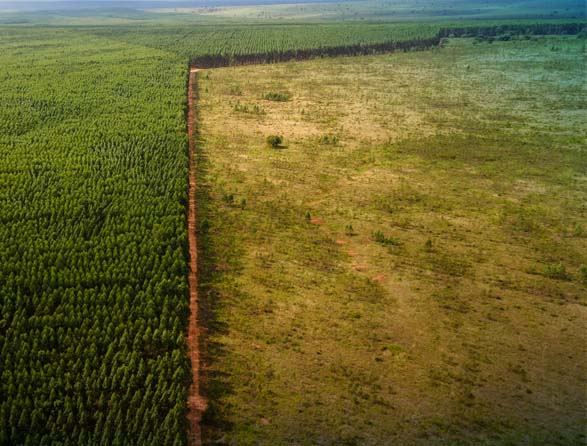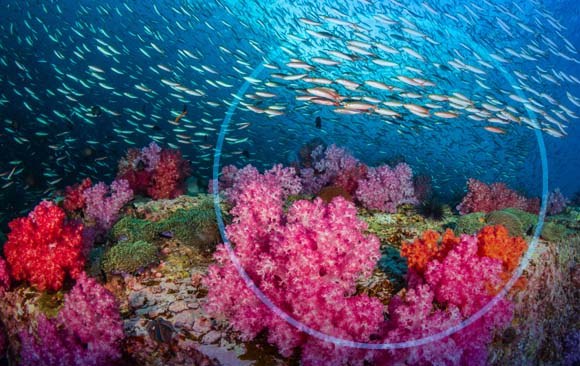Biodiversity is the variety of life on Earth at all levels, from genes to ecosystems, and the ecological and evolutionary processes that sustain it. It’s a treasure trove of wonderful, delicate and intricate life forms that provide us with invaluable natural services and a source of inspiration. However, the unfortunate reality is that biodiversity loss is occurring at an unsustainable rate.
Biodiversity loss is the silent crisis of our age. Our use of land and depletion of resources are putting “our strongest natural defense against climate change” at risk.
Here, we’ll explore the intricacies of biodiversity loss, the underlying causes, its profound impact and the innovative solutions that are being developed to combat this critical issue.
Defining biodiversity and its significance
Before we address biodiversity loss, it’s important to consider what we stand to lose. Biodiversity represents the key to the planet’s ecological balance. It provides us with food, clean water, fertile soil, medicines and a stable climate. Additionally, biodiversity contributes to the cultural heritage and spiritual well-being of people around the world.
Ecosystems maintain a subtle balance and every species plays a role. Biodiversity is resilience – it’s the ecosystem’s capacity to resist change and recover from damage.
However, these life-supporting services are at risk, leading to depletion of animal and plant populations, disruption of habitats, the introduction of invasive species and the alteration of natural cycles such as fire and flood.
Understanding the concept of biodiversity loss
Biodiversity loss is the decline in plants and animal species and their ecological roles, diversity within populations and the variety of ecosystems. It’s a critical environmental issue, often referred to as the sixth extinction event due to the similarity with previous mass extinction events in Earth’s history. The decrease in biological diversity is concerning as it has escalated dramatically because of anthropogenic activities.
Examples of decrease in biological diversity
To grasp the severity of biodiversity loss, one can look at iconic species like the tiger, which has seen its population plummet. Coral reefs, often called “rainforests of the sea,” have been rapidly degrading. Additionally, the Amazon Rainforest, which is one of the most diverse ecosystems on the planet, faces severe fragmentation and deforestation, leading to the loss of plant and animal life.
Equally alarming in the context of biodiversity loss is the impact of deforestation on crop diversity. The systematic removal of forests, driven by the expansion of agricultural land, logging for timber, and urban development, poses a direct threat not only to the habitats of countless species but also to the genetic variety of crops themselves. This loss of crop diversity, fundamental to human nutrition and food security, underscores the urgency for innovative agricultural practices.
The impact of climate change on biodiversity
Climate change and biodiversity loss are closely interlinked. Our land and ocean ecosystems are effective absorbers of carbon emissions. But, at the same time, rising temperatures, shifts in precipitation patterns and ocean acidification are just a few of the ways climate change is driving biodiversity loss. And it’s causing shifts in habitat ranges, changes in species’ life cycles and behavior and increased risk of extinction because of an inability to adapt quickly enough.
How do humans impact the environment and ecosystems?
Human activity has undoubtedly been the primary driver of biodiversity loss. Pollution, habitat destruction, overexploitation and development are just a few of our activities that have disrupted the natural world, leading to a loss of biodiversity.

Facts and figures on biodiversity loss
Experts say biodiversity loss is happening faster than at any prior time in human history. The scale of the issue is daunting. The most comprehensive reports indicate we’re in the midst of a mass extinction event, with species disappearing at rates up to 1,000 times greater than the natural background extinction rate.
According to the Living Planet Report, released by the World Wildlife Fund (WWF), populations of vertebrate animals have, on average, declined in size by 68% in recent decades.
Overall, more than 44,000 species are threatened with extinction, according to the International Union for Conservation of Nature (ICUN) Red List. That includes 41% of amphibians, 26% of mammals, 34% of conifers and 36% of reef corals.
What are the main causes of biodiversity loss?
To better comprehend the scope of biodiversity loss, let’s dig into its primary triggers. The five major causes are deeply interwoven and require multifaceted solutions.
- Habitat Destruction and Fragmentation: This is mainly due to agricultural expansion, urbanization, infrastructure development, and deforestation, which reduce natural habitats.
- Pollution: It includes various types of environmental contamination that directly harm organisms or disturb ecosystems. This encompasses land, air, and water pollution.
- Climate Change: Human-induced climate change, predominantly from carbon emissions, is altering ecosystems and making it increasingly difficult for species to survive.
- Invasive Species: Non-native species introduced by humans into new areas can become invasive and outcompete native species.
- Overexploitation: Harvesting resources at a rate that exceeds the ability of the species or ecosystem to regenerate naturally leads to overexploitation. This includes overfishing, overhunting and illegal wildlife trade.
How does biodiversity loss impact human health?
The erosion of biodiversity represents far more than an environmental concern: it fundamentally threatens human health, economic stability and societal resilience. When ecosystems degrade, the consequences ripple through every aspect of human life, from the medicines we develop to the food we eat and the diseases we face.
The World Health Organization reports that wetland degradation alone has contributed to a 35% decline in global coverage since 1970, directly impacting water availability for over 2 billion people while simultaneously increasing waterborne disease transmission. Beyond immediate health impacts, the economic ramifications prove equally staggering. More than 75% of global food crops depend on pollinators that contribute between $235-577 billion annually to agricultural output, according to WEF, yet declining bee populations now threaten this critical foundation of food security.
The pharmaceutical industry faces similar vulnerabilities, as the loss of plant and animal species eliminates potential sources for new treatments—research suggests biodiversity loss might cost humanity one important drug discovery every two years. Industries from agriculture to manufacturing depend on ecosystem services like water regulation, soil health and pest control, and when these natural systems collapse, businesses face diminished production capacity, elevated costs and reduced product quality.
What are the solutions to biodiversity loss?
Conserving biodiversity means securing the future—for our planet and for us. It means recognizing that every species, no matter how small or inconspicuous, has value in itself and its place in the tapestry of life. A shift in perspective from exploitation to stewardship is a foundation on which sustainable practices can be built.
Addressing biodiversity loss requires a multi-faceted approach. Conservation efforts must target the root causes of the problem and must be integrated into social and economic decision-making.
Strengthening protected areas and networks
Protected areas serve as havens for innumerable species, but their effectiveness is often limited by insufficient funding, management and human encroachment. It’s critical to strengthen these protected areas and connect them through ecological corridors to maximize their benefit.
Sustainable land and ocean management
Sustainable land management (SLM) refers to a set of practices and technologies that integrate the management of land, water, biodiversity and other environmental resources while also meeting evolving human needs to ensure long-term sustainability.
Adopting sustainable practices in agriculture, fishing and forestry is vital. Sustainable management ensures that we meet the needs of the present without compromising the ability of future generations to meet their own needs.
In the mining industry, an industry typically associated with extraction and destruction of resources, Dassault Systèmes has developed an offering for SLM. It includes a governing system that aggregates systems and data on the 3DEXPERIENCE platform, creating a virtual twin to minimize environmental impacts of mining operations. The SLM solutions allow users to embed regenerative and responsible mining operations through digital continuity among geospatial analysis, interactive analytics and structured collaboration.
Enhancing conservation policies and legislation
Governments and international organizations play a pivotal role in setting and enforcing policies and legislation to protect biodiversity. This includes initiatives to reduce deforestation, regulate wildlife trade and control the spread of invasive species.
In 2022, the UN hashed out a plan, called the Kunming-Montreal Global Biodiversity Framework, that represents a landmark agreement adopted by 196 countries to guide global action on biodiversity through to 2030. Along with preventing biodiversity loss, the plan includes protecting and restoring ecosystems and protecting indigenous rights.
“There are concrete measures to halt and reverse nature loss, including putting 30% of the planet and 30% of degraded ecosystems under protection by 2030,” the UN reported in early 2024. “Currently 17% of land and around 8% of marine areas are protected. The plan also contains proposals to increase financing to developing countries – a major sticking point during talks – and indigenous peoples.”
Empowering local communities
Local communities often have the most at stake in biodiversity conservation. Empowering people to manage their natural resources sustainably can lead to effective conservation practices.
Can biodiversity losses be restored?
Innovations in technology are providing new tools to monitor and manage ecosystems and species, habitat loss and pollutants. One such innovation is the use of science-based “virtual twins,” which are digital replicas of physical assets or systems, such as wildlife habitats. These virtual twins are emerging as promising technological innovations to preserve biodiversity by allowing scientists and policymakers to model and test potential interventions without causing harm to the actual environment.
“Virtual twins provide a holistic view of global interactions and allow navigation across different scales,” says Philippine de T’Serclaes, chief sustainability officer here at Dassault Systèmes. “Powered by contextualized data, they enable organizations to model and simulate from the micro to the macro level with scientific accuracy, helping them understand how each layer affects the larger issue.”
Imagine having a complete, interactive model of a rainforest or coral reef right at your fingertips. By leveraging virtual twins, we not only expand our capability to foresee the consequences of our actions on biodiversity but also enhance our ability to devise effective conservation strategies.
Innovation is key to addressing the complex issue of biodiversity losses. From new, sustainable agricultural practices powered by geospatial data analytics to improved monitoring and conservation efforts, technology can play a vital role in preserving and restoring biodiversity.
Advances such as genetic engineering and precision agriculture have the potential to increase crop diversity and reduce land use, while AI and big data can aid in identifying and protecting endangered species. Additionally, emerging technologies like drones and satellite imagery can help monitor and protect large areas of land and water that are crucial to preserving biodiversity.
These digital tools complement traditional conservation methods by providing the scale and speed necessary to address biodiversity loss at the pace it’s occurring. However, the most significant breakthrough comes from integrating circular economy principles with technological solutions. Since approximately 90% of biodiversity losses stem from human activities of resource extraction and processing at the beginning of value chains, businesses can minimize their dependence on virgin raw materials through designs prioritizing durability, reusability and recyclability. This approach reduces habitat destruction while creating systems that regenerate rather than deplete natural resources.
By embracing innovation and utilizing technology responsibly, we can work toward a more sustainable future for our planet’s diverse species. Ultimately, our continued progress as a society must coexist in harmony with the natural world if we hope to preserve biodiversity for future generations.

